When
People Meet
Animals
A production of the
Alaska Bilingual Education Center
Of the Alaska Native Education Board
4510 International Airport Road
Anchorage, Alaska
1975
Written by
Patricia H. Partnow
Illustrated by
Jeanette Bailey
6-75-500
TABLE
OF CONTENTS
CHAPTER I "Nihts'iil"
CHAPTER II "The Female Beaver"
CHAPTER III "First Salmon Story"
CHAPTER IV "A Bear Hunt"
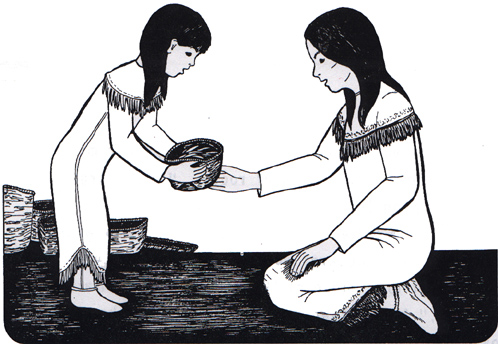 CHAPTER 1
CHAPTER 1
Nits' iil
During the spring, Upper Tanana Athabascans
used to gather nihts'iil, which are little roots that muskrats find
and hide in their caches. One day a little girl found one of these
caches on a lake and took out all the nihts'iil to take home to her
family. She was very excited and very proud of herself when she got
home with the tasty food.
"Mom!" she said, "I found a muskrat cache!
Here's some nihts'iil."
"You've got to pay for the nihts'iil, " her
mother said when she saw the pile of roots. "Don't forget to leave
something in the cache for the muskrat."
"Oh, Mom," her daughter answered, "who would
ever know! The muskrat wouldn't know that I was the one that took the
nihts'iil. What does it matter?"
"Yes," her mother answered. "The muskrat will
know. You've got to pay for what you take. The muskrat worked hard to
fill his cache, and you shouldn't empty it without paying for
it."
The daughter still wasn't convinced. "What
happens if I don't pay for it?" she asked. The mother answered, "If
you don't pay, the muskrat will go into our cache, and take out all
our meat."
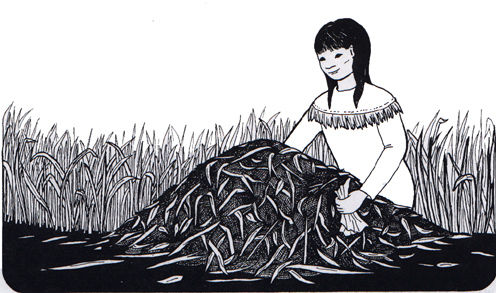
The little girl went back to the cache and
left a bit of cloth for the muskrat.
(Adapted from Guedon's People of Tetlin.
Why Are You Singing?1974: 47-48.)
CHAPTER II,
"The Female Beaver"
There is a Koyukon story that the old people
used to tell to their grandchildren on winter nights, when all the
children were warm between fur blankets. The fire in the middle of
the winter sod house would be burning low and the smell of the smoke
would blend with the smell of fresh spruce boughs covering the
floor.
The story went something like this:
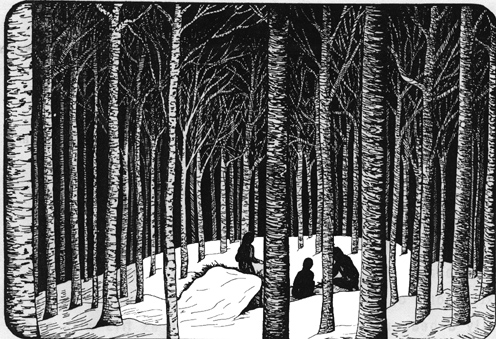
A young man was coming home from a
hunting trip late one winter day. He had been walking through deep
snow all day and was very tired, but decided to keep walking until he
got back to camp. He walked and walked, but didn't see any of the
familiar signs of home. He suddenly realized that he was lost.
It was dark by now, but he kept walking,
hoping that he would find the camp of another band. Then, he saw a
fire through the trees. There was a camp ahead, next to a lake. He
started running toward it, and when he got to the camp, was happy to
see people, at last!
The man was greeted by the people. They told
him that though they looked like people to him, they were really
beavers. He had strayed out of human territory and into beaver
land.
The young man was very tired. He looked around
at the beavers' camp. He saw a pretty young woman next to one of the
houses. Although he knew she was really a beaver, he decided to take
her as his wife and to stay in the beaver camp. He lived there all
winter long, with his new wife and her relatives.
When spring came, the young man knew that it
was time to go back to his own home. But springtime is the time of
hunger, and the beavers had no extra food to send with the young man
for his trip home.
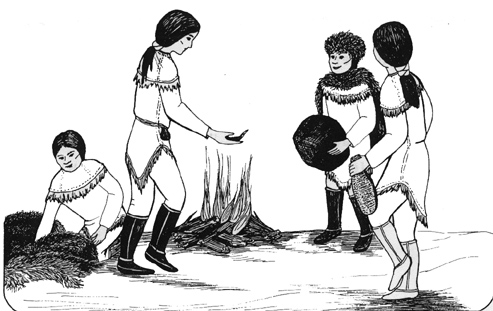
The beaver-people talked it over. They
could not give the man food from their caches, but they decided they
would let him take one of their children as food for his trip.
The young man's wife offered to be killed. She
would become food for her husband and keep him alive.
Her parents looked at their son-in-law and
said to him, "When you have finished with the meat, you must throw
the bones into the water, and say 'Tonon Litseey'." This means "be
made again in the water".
The young man agreed, and set off for his home
village with the beaver meat.
The man got home safely, thanks to the meat he
had been given. When he had eaten it all, he threw the bones into the
water and said, "Tonon Litseey."
Suddenly the female beaver who had been his
wife appeared in the water where he had thrown the bones.
She swam away to her parents' lodge.
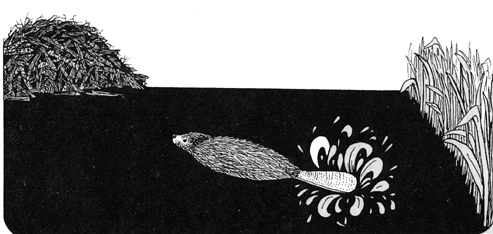
The old people would end their story by
saying, "And ever since that time, we have followed the custom of
throwing beaver bones into the water after we have eaten the
meat."
(Adapted from Sullivan's The Ten'a Food
Quest, 1942: 107-108.)
CHAPTER III
"First Salmon Story"
The Tanaina Athabascans used to tell a story
about a salmon. It goes something like this:
One spring day when it was just about time for
the salmon run to begin, a rich Tanaina man put out his fish trap as
he always did at that time of year. He hoped to catch enough salmon
to last his family for the whole year. The man told his daughter not
to go near the fish trap.
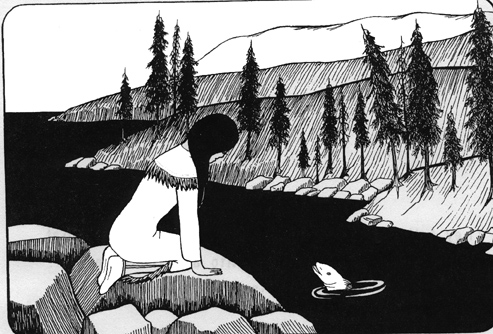
His daughter was curious. She wondered why her
father did not want her to see the trap. So, instead of obeying him,
she walked down to the river toward the trap. "Ill be back in a
little while," she called to her father as she walked away.
When the girl got down to the river, she went
straight to the trap. A big king salmon was swimming around in the
water, and she started talking to him.
They talked and talked, and before she knew
what was happening, she had turned into a salmon herself! She slid
into the water and disappeared with the big king salmon.
The girl's father looked everywhere for his
daughter. He could not find her. Every day he called her and searched
for her, but she never returned.
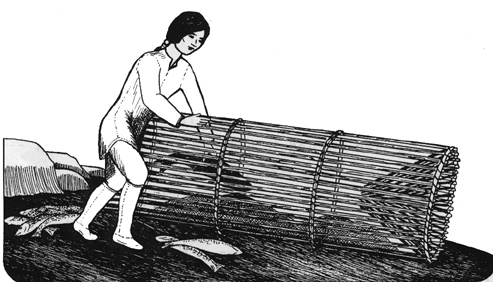
The next year, when the salmon run was about
to start again, the rich man set out his fish trap as usual. The
first time he checked it, he saw that it was fill with many beautiful
salmon. The man threw them all out on the grass, and began cleaning
them. He left the smallest fish for last.
Finally, all but the last small fish had been
cleaned. The man turned to pick up the little salmon --and saw that,
where the fish had been, there was now a little boy!
The man walked around the boy, staring at him.
He walked around him three times. And finally, the third time, he
knew why the boy looked familiar. He looked just like the man's lost
daughter. The man suddenly knew that this young boy was his grandson,
the son of his missing daughter.
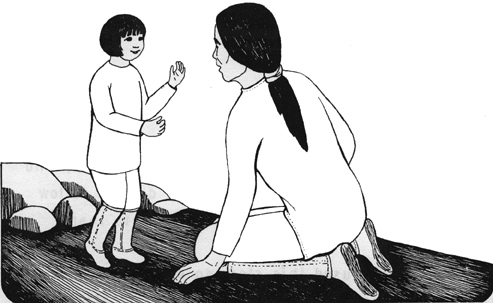
The boy finally spoke to his grandfather. He
told him all the things he should do to show his respect for the
salmon. He told the man how to cut the sticks to dry the salmon, and
how to be careful not to drop the salmon on the ground while they
were being dried. And he told the man that each year, when the first
salmon of the year was caught, the people should hold a ceremony for
that salmon. They must wash themselves, and dress up in their finest
clothes. They must find a weed near timberline, and burn it. And they
must clean and cook the first fish without breaking its backbone. The
insides must be thrown back into the water.
The boy explained that if the man and his
people did all these things, they would have a good year, and would
catch many salmon. But if they did not follow the rules, the salmon
would never return to them.
The Tanaina used this story to explain to
their children how the First Salmon Ceremony got started and why it
was performed each year in the springtime. The people did everything
the young salmon-boy had told his grandfather to do.
(Adapted from Osgood's The Ethnography
of the Tanaina, 1966: 148-149.)
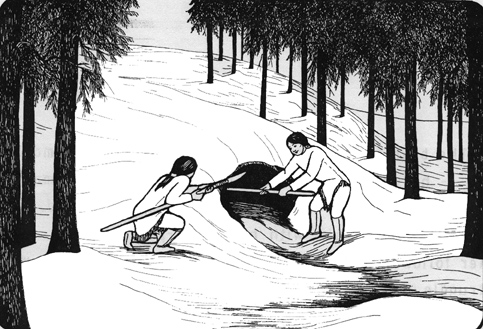
CHAPTER IV,
"A Bear Hunt"
A Koyukon Athabascan man and his son had been
out hunting one winter day. On the way back to camp, they discovered
a bear hole. The older man stuck the end of his long bear spear into
the hole, hoping to wake the bear up and make him leave his hole. He
poked and poked, while his son stood nearby with his own spear ready
to stab the bear as it came out of the hole.
The bear started growling. The man felt him
moving about -- he was going to come out! As the big animal emerged
angrily from his den, the two men panicked.
The son lunged at him with his sharp-pointed
spear. His father followed with another stab at the bear. There was a
struggle -- and the bear fell down, and slid back into his
den.
The two men were horrified. They knew that
after a bear has been killed, its forepaws must be cut off, and its
eyes must be burst. Although the bear was dead, its spirit, or yega,
could still harm the men if these things were not done.
The man and his son tried to remove the bear
from the hole, but it was already dark by this time and the bear was
very heavy. They could not pull it out.
The men returned to camp. They felt very
worried. because they had not followed the rules. The bear's yega
would be angry. Days and weeks went by, and nothing bad happened to
either one. Finally, they forgot about the dead bear in its
den.
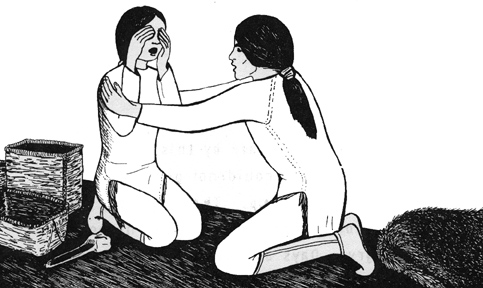
A year later, the son went blind. The people
in his band said he had gone blind because he had broken a rule--he
had failed to burst the bear's eye after killing it.
(Adapted from Sullivan's The Ten'a Food
Quest, 1942: 86.)